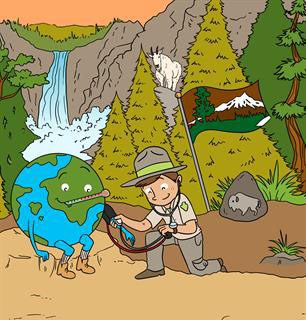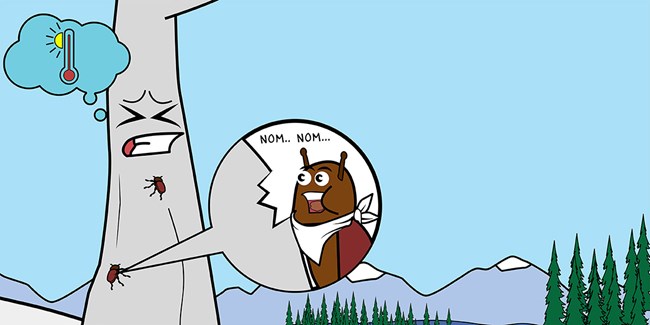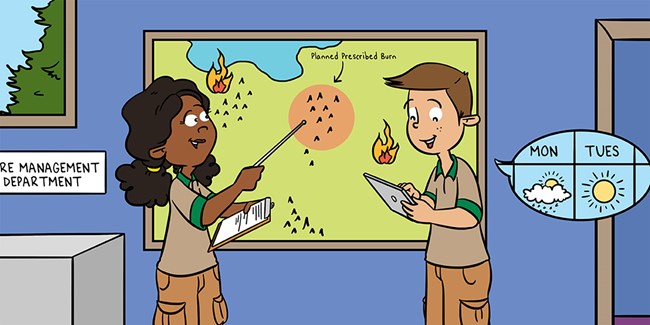
Credit: Frontiers for Young Minds
How do we know if parks are healthy? We measure their vital signs, of course! Across the country, there are 32 inventory and monitoring networks that measure the status and trends of all kinds of park resources. We're learning a lot after years of collecting data.
These articles are a part of a collection, or special issue, of Frontiers for Young Minds, an international online journal of science written for kids and involving kids in the review process. Taking the Pulse of U.S. National Parks presents what we are learning from years of monitoring plants and animals and physical conditions in parks. The articles featured below include results from monitoring in Sierra Nevada parks or highlight topics in other I&M networks that are relevant in our parks.

Credit: Frontiers for Young Minds
Nutrients in Mountain Lakes: How Much Is too Much?
Yosemite, Kings Canyon, and Sequoia national parks protect over 1,200 mountain lakes. These lakes provide healthy homes for plants and animals and supply clean water to downstream communities. These clear blue lakes are high up in the mountains, where they receive very low amounts of nutrients from the watershed. Nutrients help living things grow and be healthy. However, human activities from communities upwind are adding nutrients into the air. These nutrients travel on air currents to remote watersheds via rain, snow, and dry particles. They increase lake algae growth, which disrupts the balance of plants and animals. We conducted experiments to determine the amount of nutrients it takes to increase algae growth. We compared these levels to current lake nutrient concentrations and found that over half of the lakes had concentrations that were below the determined early warning point and just under half were at levels of higher concern.
Also see:
Monitoring lakes in the Sierra Nevada
Clear Waters story map
Heard, A., J. Sickman, and L. Mutch. 2021. Nutrients in Mountain Lakes: How Much Is too Mutch? Front. Young Minds. 10:716512. doi: 10.3389/frym.2022.716512.

Credit: Frontiers for Young Minds
Have you ever hiked up a mountain and felt a frosty wind blowing across your face? You might need to button up your jacket to visit this place, but here, whitebark pine trees are right at home. Whitebark pine trees thrive in the highest forests of western North America. In these environments, whitebark pines help other, less-hardy species to establish, grow, and survive. For this pine, chilly mountaintops provide refuge from insects, disease, and competition with other trees. Yet as our climate changes, whitebark pine trees no longer have the cold on their side. They are dying at alarming rates, and one of the biggest killers is a tiny bark beetle. How is climate change helping this little insect munch through huge swaths of forest? National Park Service scientists use long-term monitoring studies to unravel this complicated relationship. This information guides resource managers entrusted with protecting whitebark pines.
Also see:
Monitoring high-elevation forests in the Sierra Nevada and in the Greater Yellowstone networks
Roche, A., E. Shanahan, and J. Nesmith. 2022. Trouble in the Forest: Whitebark Pine Trees, Mountain Pine Beetles, and Climate Change. Front. Young Minds. 10:678082. doi: 10.3389/frym.2022.678082.

Credit: Frontiers for Young Minds
Rising from the Ashes: The Role of Fires in National Parks
Fire is a natural and healthy part of many ecosystems, and many plant species rely on it to reproduce. Some species require the actual heat and flames for their seeds to be released and sprout. Other species rely on fire to burn o dried needles and leaves on the ground as well as many of the shrubs and small trees. This opens up the forest and allows more space and light for small plants and trees. While fire is a good thing for many plants and ecosystems, this is not the case everywhere. In areas that get high amounts of rain, ecosystems are not adapted to fire. Human-caused fires in these places can be devastating to the plants there. It is the job of fire managers and ecologists to manage wildfires, make decisions about fire suppression, and decide if additional fires are needed in key ecosystems.
While we often monitor areas that have burned, we do not have a specific monitoring project dedicated to fire and its effects. However, managers and scientists in Sierra Nevada parks conduct prescribed burns and manage wilderness fires, along with suppressing wildfires. Learn more about the critical role fire plays in Sierra Nevada forests as well as impacts of severe wildfires from increaing forest densities and fuels, drought, and warming climate:
Giant Sequoias and Fire (in Sequoia & Kings Canyon National Parks)
Giant Sequoias and Climate (in Sequoia & Kings Canyon National Parks)
Managing Wildfire, Prescribed Fire, and Fuels (in Yosemite National Park)
Sanders, S., L. Mutch, M. Wasser, J. Barnes, and S. Perles. 2021. Rising from the Ashes: The Role of Fires in National Parks. Front. Young Minds. 9:627635.doi: 10.3389/frym.627635
Explore Articles from Other National Parks
Last updated: September 8, 2023
